CRISPR-based gene editing with CTX001 as a potential functional cure for transfusion-dependent β-thalassemia and sickle cell disease
In the CLIMB THAL-111 and CLIMB SCD-121 trials, CRISPR-Cas9 gene editing with CTX001 was identified as a potential functional cure for patients with transfusion-dependent β-thalassemia and sickle cell disease. An early report of the first ten patients with at least three months of follow-up indicate that all the individuals with β-thalassemia have become transfusion independent and none of the SCD patients experienced a vaso-occlusive crises since CTX001 infusion. Furthermore, all patients showed a substantial and sustained increase in the production of foetal haemoglobin.
Background
BCL11A is a key transcription factor that suppresses the production of foetal haemoglobin (HbF) in red blood cells (RBCs), leading to the production of adult Hb (HbA). In diseases with haemoglobin production defects such as β-thalassemia and sickle cell disease (SCD), HbF upregulation could potentially ameliorate anaemia and reduce transfusion requirements in β-thalassemia, or vaso-occlusive crises (VOCs) in patients with SCD. With the ex vivo CRISPR-Cas9–based gene-editing platform the erythroid enhancer region of BCL11A in haematopoietic stem and progenitor cells (HSPCs) can be edited, to produce CTX001. The CLIMB THAL-111 and CLIMB SCD-121 trials are phase I/II multi-centre, open-label, single-arm first-in-human studies of CTX001 for transfusion-dependent β-thalassemia (TDT) and SCD, respectively. Target enrolment for CLIMB THAL-111 is 45 patients aged 12 to 35 years with TDT, including β0/β0 genotypes, defined as a history of ≥100 mL/kg/year or ≥10 units/year of packed red blood cell transfusions in the previous two years. Target enrolment for CLIMB SCD-121 is 45 patients aged 12 to 35 years with severe SCD and a history of ≥2 VOCs/year in the previous two years. Peripheral CD34+ haematopoietic stem cells from patients were collected by apheresis after mobilisation with filgrastim and plerixafor (for TDT) or plerixafor alone (for SCD). The erythroid enhancer region of BCL11A was edited in CD34+ cells using CRISPR-Cas9 editing. Prior to the CTX001 infusion on day one, patients underwent myeloablative conditioning with busulfan for four days. Patients were subsequently monitored for engraftment, haematopoietic recovery, adverse events, haemoglobin production, haemolysis, HbF and F-cell expression, pRBC transfusion requirements (TDT) and VOCs (SCD).
Results
At ASH 2020, primary data were presented of the first ten patients infused with CTX001 (TDT, N=7; SCD, N=3) who have at least three months of follow-up. In the patients with TDT, median neutrophil engraftment occurred on day 32 with a median platelet engraftment on day 37. Median duration of follow-up in these patients was 8.9 months. In patients with SCD, the median neutrophil engraftment occurred on day 22 and median platelet engraftment was reported at day 30. All patients demonstrated increases in total Hb and HbF that were achieved early and were maintained over time. In the seven TDT patients with three months of follow-up, the median total Hb was 11.5 g/dL with a median HbF of 8.4 g/dL. Of note, both patients with severe β0/β+ (IVS-I-110) had normal haemoglobin levels at the last follow-up visit. In addition, six months after CTX001 infusion, 99.8% of red blood cells (RBCs) expressed HbF. This translated into transfusion-independence within the first two months for all patients.
Also, for the three patients with SCD clinically meaningful HbF and total Hb improvements were achieved early and this was maintained over time. At last follow-up, the HbF in these patients ranged from 31% to 48%. Using flow-cytometry, the circulating RBCs expressing HbF were examined. Five months after infusion, 99% of RBCs expressed HbF. For these SCD patients, the elevation of HbF translated into clinical benefit in all three patients with none of the patients experiencing any VOCs after CTX001 infusion. BCL11A editing observed in bone marrow CD34+ cells was monitored at six and twelve months after infusion. For the two patients with at least twelve months of follow-up (one with TDT and one with SCD) there was no difference in percentage CD34+ bone marrow cells that were allelic edited, indicating persistent and stable engraftment.
In all patients, adverse events (AEs) were generally consistent with myeloablation and autologous stem cell transplant and the majority of AEs occurred within the first 60 days after CTX001 infusion. One patient with TDT experienced four serious adverse events (SAEs), related or possibly related to CTX001: headache, haemophagocytic lymphohistiocytosis (HLH), acute respiratory distress syndrome, and idiopathic pneumonia syndrome. All four of these SAEs occurred in the context of HLH and have resolved. No other CTX001-related SAEs were reported in the remaining six patients with TDT. Post-CTX001, one patient with SCD experienced SAEs: sepsis (related to busulfan), cholelithiasis, and abdominal pain (both unrelated to any study drug) of which all resolved. There were no SAEs related to CTX001.
Conclusions
The first ten patients treated with CTX001 have now been followed for 3.8 to 21.5 months and have stopped transfusions (TDT) and are VOC-free (SCD). The overall safety profile of CTX001 is generally consistent with myeloablative conditioning and autologous bone marrow transplant. Clinically meaningful HbF and total haemoglobin levels are observed early and maintained across all ten patients. Clinical proof-of-concept for CTX001 has now been demonstrated for both TDT and SCD and mark CTX001 is a potential functional cure for the treatment of both TDT and SCD.
Reference
Frangoul H, Bobruff Y, Cappellini MD, et al. Safety and Efficacy of CTX001 in Patients with Transfusion-Dependent β-Thalassemia and Sickle Cell Disease: Early Results from the Climb THAL-111 and Climb SCD-121 Studies of Autologous CRISPR-CAS9–Modified CD34+ Hematopoietic Stem and Progenitor Cells. Presented at ASH 2020; Abstract 4.

